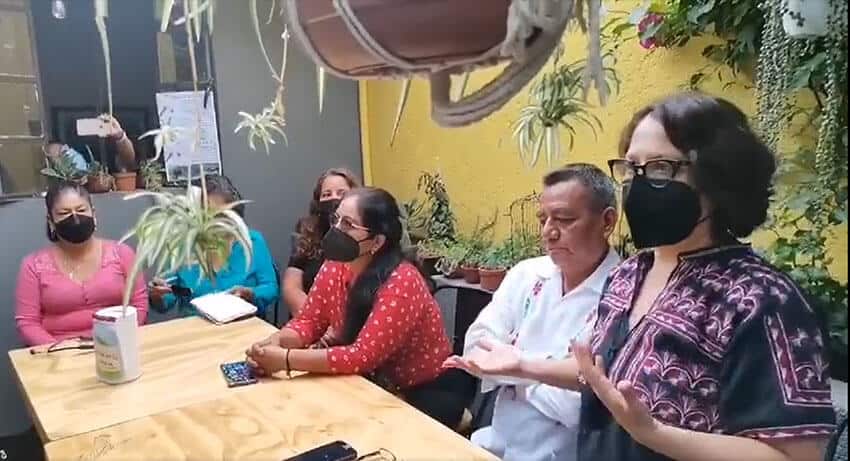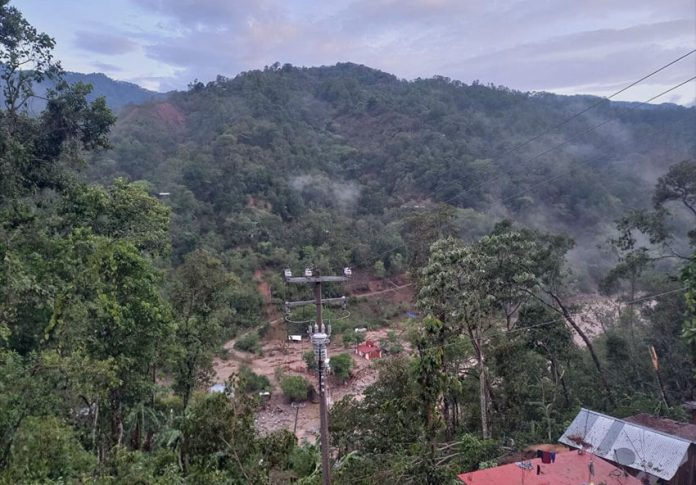Residents of a small municipality in the mountains of Oaxaca are still without power and haven’t received any disaster assistance since they were pummeled by Hurricane Agatha on May 30, according to the newspaper Milenio. To make matters worse, residents say their mayor has abandoned them and has taken up residence in Oaxaca city.
The citizens of San Mateo Piñas, a town of about 2,000 people, say that because authorities and various government agencies have not done anything to help, they are now asking the federal government to take action, as they are still without sufficient food, drinking water or housing. They demanded that the army and President López Obrador address their situation and deliver humanitarian aid through the airlift installed at the Huatulco airport, Milenio reported.
San Mateo Piñas is located in the Sierra Sur, about 37 kilometers from the town of Santa María Huatulco via a small mountain road. But residents say landslides on the highway have made it impassable and have left them isolated and “incommunicado.” Instead of being able to drive to Huatulco in less than two hours, villagers and others now have to walk on mountain paths for up to 15 hours to get there, one person said.
At a press conference in the city of Oaxaca, relatives of those affected by the hurricane said they had set up three collection centers for food and other useful items, and that in a week, they collected six or seven tonnes of support. But, they added, they do not have the means to transfer any of it to the devastated community.
Here is some of the damage left behind by Hurricane Agatha in Mexico—this road reaches San Mateo Piñas, a community of about 1,500 that has been cut off following the storm. Their water system also collapsed, so we’re bringing drinking water in addition to food. #ChefsForOaxaca pic.twitter.com/qtUemGCVjs
— World Central Kitchen (@WCKitchen) June 5, 2022
Mayor Tomás Victorio García also was criticized for not having assumed his responsibility so far. “He responds from his cell phone, from his home in the city of Oaxaca, he is never in the town,” one person said.
They also denied the mayor’s statements that he came to Piñas on a motorcycle to check out the damage, and then returned to the city of Oaxaca to file a report. “That is impossible,” said one person, “because the community is not reachable.”
However, residents of the affected area have sent photographs to relatives and friends, and some of those have been published on social media. People are able to charge their cellphones, one person said, only because some have solar panels.
Ana Elisa Garcia Galán, originally from San Mateo Piñas, told reporters in Oaxaca city on Thursday that the help being asked for is a “matter of humanity.” She said people are fed up with politicians “because they don’t attend to the demands of the people.”

Garcia added that people are eating soup and running out of food. “Two days ago, I posted on my Facebook that we’ve had 30 minutes of rain [in the city of Oaxaca] and everyone is freaking out because of floods. Now imagine six hours of heavy rain, plus the wind, and your house is falling down. Everything that you have worked to have has fallen down.” That, she added, is a whole different kind of reality.
According to news sources, Hurricane Agatha, with winds of 165 kph, was the strongest hurricane to make landfall along the Pacific coast of Mexico in the month of May since records began in 1949. It hit land as a Category 2 hurricane, bringing heavy rains that triggered landslides and flash flooding.
Media reports have put the death toll at 11 people, with several dozen others missing. However, Defense Minister Luis Cresencio Sandoval said nine people had died with five missing. He said the hurricane damaged 31 municipalities, where there were 25,134 affected families for a total of 100,544 people.
He added that 28,021 homes were damaged, the water system collapsed in eight municipalities, 70,082 users were left without electricity in 21 municipalities, 560 kilometers of highways and roads were damaged, 16 bridges collapsed and there was damage to coffee, papaya and sesame crops. Germán Martínez Santoyo, the head of the National Water Commission, reported that 90% of the drinking water systems in the region were affected, and 20% of the drainage systems suffered damage.
In nearby Puerto Escondido, where the hurricane did comparatively little damage, many residents have stepped in to provide emergency aid to hurricane victims in the region, particularly those living in remote mountain communities.
Sembrando Buenas Semillas and Helping Hands Puerto Escondido are among groups providing household supplies and lonas, or tarps, to replace roofs that were damaged by high winds. Some eyewitnesses have told Mexico News Daily that residents of numerous small communities have been left with nothing.
The organizations are collecting funds to purchase supplies with a campaign on FundRazr.
With reports from Mileno, El Universal and El Economista
